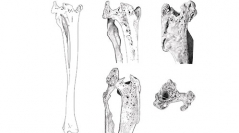

 Comptes Rendus Palevol
18 (8) - Pages 1011-1023
Comptes Rendus Palevol
18 (8) - Pages 1011-1023Few pathological cases have been identified in fossils of small mammals. Here we report the most ancient paleopathological evidence identified in a lagomorph (Ochotonidae, middle Miocene). The tibiofibular bone was macro- and microscopically (μCT) inspected to provide a diagnosis, an etiology, and its possible relationship with the individual's cause of death. Osteogenesis (reactive bone growth) and osteolysis, processes related with neoplasms and infections, are identified in the abnormal bony region. Its location (juxta-articular) and morphology allow us to identify it as a joint infection (septic arthritis) consequential of a violent mechanism, such as a bite. Both the origin of bone accumulation (avian pellets) and the poor vital state of the specimen (with a joint infection) point to predation as the most probable cause of death. Up to now, lagomorph paleopathologies had only been described in insular populations, and the present one is the first evidence in a mainland specimen.
Goldberg site, MN6, Ochotonid, osteolysis, septic arthritis, small mammals